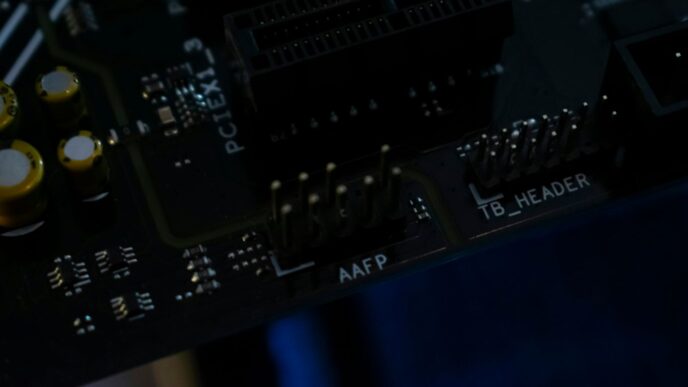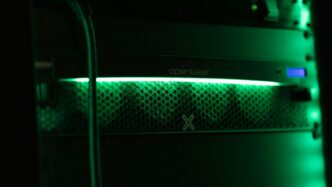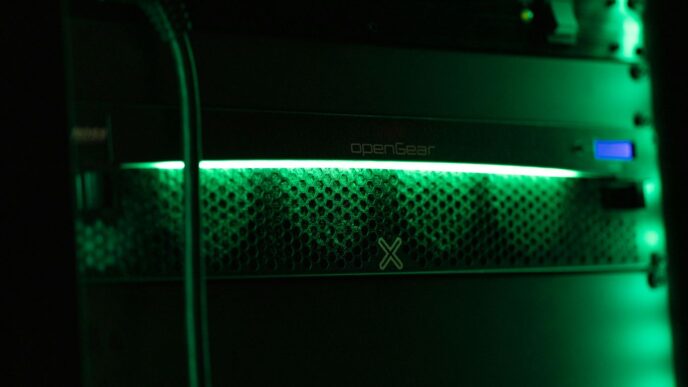Artificial Intelligence (AI) is changing how we explore space. It’s not just helping us gather information; it’s also making space missions smarter and safer. From navigating spacecraft to analyzing data, AI is playing a vital role in our journey to understand the universe. This article will explore how AI is transforming space exploration and what it means for our future in the cosmos.
Key Takeaways
- AI has evolved from simple tasks to complex decision-making in space missions.
- Autonomous spacecraft can navigate and operate with little human help.
- AI helps plan missions by analyzing data for optimal launch times and routes.
- Robots powered by AI can explore dangerous areas on other planets.
- Machine learning improves communication with spacecraft, ensuring steady data flow.
The Evolution of AI in Space Exploration
Early Uses of AI in Space Missions
In the early days of space exploration, AI was just starting to make its mark. Basic AI systems were used mainly for data analysis and logistics. These early applications were simple but crucial in laying the groundwork for future advancements. Some key points include:
- Data processing for mission planning.
- Basic anomaly detection in spacecraft systems.
- Support for decision-making in mission control.
Key Milestones in AI Development
As technology progressed, AI began to play a more significant role in space missions. Here are some important milestones:
- 1980s: Introduction of AI for satellite operations.
- 1990s: Use of AI in the Mars Pathfinder mission.
- 2000s: Advanced AI systems in the Mars rovers, allowing for autonomous navigation.
Impact on Modern Space Missions
Today, AI is integral to modern space missions, enhancing efficiency and safety. It allows spacecraft to:
- Navigate autonomously in real-time.
- Analyze vast amounts of data quickly.
- Make decisions without human intervention, especially in deep space where communication delays occur.
The evolution of AI in space exploration is not just about technology; it’s about expanding our understanding of the universe and our place within it.
AI continues to push the boundaries of what is possible in space travel, making it an exciting field to watch as it develops further.
AI-Driven Autonomous Spacecraft Operations
Artificial intelligence (AI) is transforming how spacecraft operate in space. These intelligent systems allow for greater autonomy, reducing the need for constant human oversight.
Autonomous Navigation Systems
AI plays a crucial role in helping spacecraft navigate through space. Here are some key functions:
- Real-time data analysis: AI systems analyze sensor data to determine the best flight paths.
- Obstacle avoidance: They can detect and avoid obstacles in their path.
- Adjusting trajectories: AI can make necessary changes to the spacecraft’s course based on environmental conditions.
Onboard Decision-Making Capabilities
AI enhances decision-making onboard spacecraft by:
- Evaluating situations: AI assesses unexpected events and determines the best course of action.
- Prioritizing tasks: It can prioritize scientific observations based on mission goals.
- Adjusting parameters: AI can modify mission parameters in real-time to improve efficiency.
Reducing Human Intervention
The use of AI significantly reduces the need for human control, especially in deep space missions where communication delays can be lengthy. This autonomy allows spacecraft to:
- React quickly to changes in their environment.
- Perform complex tasks without waiting for instructions from Earth.
- Maintain operational efficiency even when human operators are not available.
AI is not just a tool; it is becoming a vital partner in space exploration, enabling missions that were once thought impossible.
AI in Mission Planning and Execution
Optimizing Launch Windows
AI plays a vital role in determining the best times to launch spacecraft. By analyzing various factors, it helps identify optimal launch windows, which can significantly impact mission success. This precise planning is essential for intricate maneuvers.
Trajectory Calculations
AI systems are used to calculate the best paths for spacecraft. They consider multiple variables, such as gravitational forces and fuel efficiency, to ensure that missions are executed smoothly. Here are some key points:
- Real-time data analysis for accurate trajectory predictions.
- Adjustments based on environmental conditions to enhance safety.
- Minimizing fuel consumption through optimized paths.
Fuel Requirement Analysis
Understanding fuel needs is crucial for any space mission. AI helps in estimating the amount of fuel required for different phases of the mission. This analysis includes:
- Calculating fuel for launch and landing.
- Assessing fuel needs for course corrections.
- Predicting fuel usage based on mission duration.
AI’s ability to analyze vast amounts of data allows for better planning and execution of space missions, making exploration more efficient and reliable.
Enhancing Data Analysis and Interpretation with AI
The vast amounts of data collected during space missions require advanced AI techniques to analyze and interpret effectively. AI algorithms are essential for making sense of this data.
Handling Vast Amounts of Data
- AI can process large datasets quickly, which is crucial for timely scientific discoveries.
- It helps in filtering out noise from the data, allowing scientists to focus on significant findings.
- AI tools can automate repetitive tasks, freeing up researchers to concentrate on more complex analyses.
Pattern Recognition and Anomaly Detection
AI excels at identifying patterns in data, which can lead to important discoveries. Here are some key points:
- Detecting celestial objects: AI can analyze images from telescopes to find new stars and planets.
- Identifying anomalies: It can spot unusual readings from instruments, alerting scientists to potential issues.
- Accelerating research: By recognizing trends, AI helps scientists make faster decisions about where to focus their efforts.
Real-Time Data Processing
AI’s ability to process data in real-time is a game changer for space missions:
- It allows for immediate analysis of incoming data from spacecraft.
- Quick decision-making can enhance mission safety and efficiency.
- AI can adapt to changing conditions, ensuring that the most relevant data is prioritized.
The integration of AI in data analysis not only speeds up research but also opens new avenues for exploration, pushing the boundaries of what we know about the universe.
In summary, AI is transforming how we analyze and interpret data in space exploration, making it a vital tool for scientists and researchers.
AI-Powered Robotics for Planetary Exploration
Robotic Systems for Hazardous Environments
AI-powered robots are essential for exploring dangerous places in space. These robots can:
- Navigate rough terrains
- Conduct experiments in extreme conditions
- Collect samples without risking human lives
Their ability to operate autonomously is crucial for safety and efficiency.
Autonomous Surface Navigation
These robots use advanced AI to move around planetary surfaces. They can:
- Analyze their surroundings in real-time
- Avoid obstacles like rocks and craters
- Make decisions without waiting for instructions from Earth
This autonomy allows them to explore areas that are hard to reach.
Scientific Experimentation and Data Collection
AI robots are not just explorers; they are also scientists. They can:
- Select the best spots for sample collection
- Use tools to gather data and analyze it on-site
- Send important information back to Earth
The integration of AI in robotic systems is revolutionizing how we study other planets, making it possible to gather data that was once out of reach.
In summary, AI-powered robotics are transforming planetary exploration by enabling safe navigation, autonomous decision-making, and efficient data collection. These advancements are paving the way for future missions to distant worlds, enhancing our understanding of the universe.
Machine Learning in Space Communication Systems
Optimizing Data Transmission
Machine learning is crucial for improving how we send and receive data in space. By using smart algorithms, we can:
- Analyze data patterns to enhance transmission efficiency.
- Adjust communication protocols based on real-time conditions.
- Predict the best times for data transfer to avoid delays.
Predicting Communication Disruptions
AI helps in anticipating problems that might interrupt communication. This includes:
- Monitoring satellite positions and conditions.
- Using historical data to identify potential issues.
- Implementing solutions before disruptions occur.
Ensuring Steady Data Flow
Maintaining a consistent flow of information is vital for space missions. Machine learning aids in:
- Balancing loads across multiple communication channels.
- Detecting and correcting errors in data transmission.
- Adapting to changing conditions in space environments.
The use of machine learning in space communication not only enhances efficiency but also ensures that vital data reaches its destination without interruption.
In summary, machine learning is transforming space communication systems, making them more reliable and efficient. This technology is essential for the success of future space missions, ensuring that we can communicate effectively across vast distances. The future of space exploration relies heavily on these advancements.
Future Prospects of AI in Space Exploration

The future of AI in space exploration is bright and full of possibilities. AI technologies are set to revolutionize how we explore the universe. Here are some key areas to watch:
Adaptive Learning Systems
- These systems will help spacecraft adjust to changing conditions in real-time.
- They can learn from past missions to improve future performance.
- This adaptability is crucial for long-duration missions where conditions can be unpredictable.
Collaborative Projects and Partnerships
- NASA and tech companies are teaming up to develop advanced AI tools.
- These partnerships aim to enhance communication and data analysis capabilities.
- Private companies are also creating technologies that support both government and commercial missions.
Innovations by Private Sectors
- Companies are investing in AI to improve space travel efficiency.
- New technologies are being developed to tackle challenges in space exploration.
- This innovation is essential for making space travel more accessible and sustainable.
The integration of AI in space exploration not only enhances our capabilities but also opens doors to new discoveries that were once thought impossible.
In summary, the future of AI in space exploration is not just about technology; it’s about pushing the boundaries of what we can achieve in our quest to understand the cosmos.
AI’s Role in Enhancing Spacecraft Safety
Fault Detection and Self-Repair Mechanisms
AI plays a crucial role in ensuring the safety of spacecraft by enabling fault detection and self-repair mechanisms. These systems can:
- Monitor equipment health in real-time.
- Identify potential failures before they occur.
- Suggest repairs or adjustments to maintain functionality.
Anomaly Detection Systems
AI systems are designed to detect anomalies in spacecraft operations. This includes:
- Analyzing sensor data for unusual patterns.
- Alerting mission control about potential issues.
- Automatically adjusting systems to prevent failures.
Improving Mission Reliability
The integration of AI enhances the overall reliability of space missions. Key benefits include:
- Faster response times to unexpected situations.
- Reduced need for human intervention, especially in deep space.
- Increased mission success rates due to proactive management.
AI is transforming how we approach spacecraft safety, making missions more reliable and efficient. By utilizing advanced algorithms, spacecraft can react swiftly to challenges, ensuring a safer journey through the cosmos.
| Safety Feature | AI Contribution |
|---|---|
| Fault Detection | Early identification of potential issues |
| Anomaly Detection | Real-time monitoring and alerts |
| Self-Repair Mechanisms | Automated adjustments to maintain systems |
Ethical Considerations in AI-Driven Space Exploration
As we venture deeper into space with the help of artificial intelligence, it’s crucial to think about the ethical implications of our actions. Here are some key points to consider:
Ensuring Responsible AI Use
- Transparency: Space agencies should clearly explain how AI systems make decisions. This helps build trust and allows for better teamwork.
- Accountability: It’s important to know who is responsible when AI makes mistakes. Clear rules can help address any issues that arise.
- Fairness: AI should be designed to avoid biases. This means constantly checking the data it learns from to ensure it treats everyone fairly.
Balancing Innovation and Safety
- Human Oversight: While AI can do many tasks, humans should still be involved to ensure safety and effectiveness.
- Training and Skills: Relying too much on AI might weaken human skills over time. Regular practice is essential to keep these skills sharp.
- Adaptability: AI must be able to handle unexpected situations in space, which can be very different from what it was trained for.
AI will not replace humans. It will augment them. AI can help us to explore in ways that humans alone cannot.
In conclusion, as we explore the universe, we must navigate the ethical challenges of using AI. By focusing on responsible practices, we can ensure that our journey into space is both innovative and safe. The goal is to create a partnership between humans and AI that enhances our exploration efforts while being mindful of the potential risks involved.
Case Studies of AI in Space Missions
NASA’s Perseverance Rover
NASA’s Perseverance Rover is a prime example of how AI enhances exploration on Mars. Equipped with advanced AI systems, it can:
- Navigate autonomously across the Martian surface.
- Analyze soil samples and identify potential signs of past life.
- Make real-time decisions based on its surroundings.
This rover is designed to operate with minimal human intervention, showcasing the power of AI in space exploration.
AI in Hubble Space Telescope
The Hubble Space Telescope utilizes AI to improve its data collection efficiency. Key features include:
- Automated image processing to identify celestial objects.
- Anomaly detection systems that alert scientists to unexpected changes.
- Enhanced data analysis capabilities that allow for quicker scientific discoveries.
These AI systems help Hubble continue to provide valuable insights into the universe.
Voyager Probes and Their Legacy
The Voyager probes, launched in the 1970s, are remarkable for their longevity and the role of AI in their operations. They:
- Use AI for real-time decision-making, allowing them to adapt to unforeseen challenges.
- Collect and transmit data back to Earth, even after decades in space.
- Have surpassed their original mission goals, providing insights into the outer planets and beyond.
Voyager’s success illustrates the importance of AI in extending mission life and capabilities.
AI has transformed space missions from simple data collection to complex, autonomous operations, paving the way for future explorations.
Challenges and Limitations of AI in Space

When it comes to using AI in space exploration, there are several challenges and limitations that need to be addressed. Here are some key points to consider:
Technical and Operational Challenges
- Technical Failures: Even the best AI systems can face unexpected problems that might jeopardize missions if not managed properly.
- Unpredictable Space Environments: The extreme conditions of outer space can create situations that AI may not be prepared for, leading to potential malfunctions.
- Dependence Risks: Relying too much on AI can weaken human skills over time, as people may not practice their expertise regularly.
Overcoming Communication Delays
- Long Distances: Communication between Earth and spacecraft can take a long time, making it hard for AI to get immediate feedback.
- Data Transmission Issues: AI must handle delays in data transfer, which can affect decision-making during critical moments.
- Real-Time Processing Needs: AI needs to process data quickly to make timely decisions, especially when dealing with emergencies.
Balancing Autonomy and Control
- Human Oversight: It’s essential to maintain a balance between AI autonomy and human control to ensure safety and effectiveness.
- Training AI Systems: AI must be trained to handle various scenarios, but this can be challenging due to the unpredictable nature of space.
- Ethical Considerations: As AI becomes more integrated into space missions, ethical concerns about its use and decision-making processes must be addressed.
Understanding these challenges is crucial for finding the right balance when integrating AI into space missions. It’s about using state-of-the-art technology while still maintaining the necessary human supervision.
In conclusion, while AI offers many advantages for space exploration, it also presents significant challenges that must be carefully navigated to ensure successful missions.
Conclusion
In conclusion, artificial intelligence is changing the way we explore space. It helps us send spacecraft farther and make smarter decisions without needing constant help from Earth. As we look to the future, AI will continue to play a big role in our adventures in space. From guiding robots on distant planets to analyzing huge amounts of data, AI is making space travel safer and more efficient. This technology not only helps us learn more about the universe but also inspires us to dream bigger. With AI by our side, the possibilities for space exploration are endless.
Frequently Asked Questions
What is AI in space exploration?
AI in space exploration refers to the use of artificial intelligence technologies to help spacecraft and robots operate more efficiently and make decisions without human help.
How has AI changed space missions?
AI has made space missions safer and more efficient by allowing spacecraft to navigate, analyze data, and perform tasks on their own, reducing the need for constant communication with Earth.
What are some examples of AI in space exploration?
Examples include the Mars rovers, which use AI to navigate the surface, and the Hubble Space Telescope, which employs AI to process images and identify objects in space.
How does AI help with data analysis in space?
AI helps analyze large amounts of data collected during missions by identifying patterns and anomalies, making it easier for scientists to understand the information.
What role does AI play in spacecraft safety?
AI enhances spacecraft safety by detecting faults, predicting issues, and enabling self-repair mechanisms, which help ensure missions are successful.
What are the future prospects of AI in space exploration?
Future prospects include more advanced autonomous robots for planetary exploration, adaptive learning systems for long missions, and collaborations between space agencies and tech companies.
Are there any ethical concerns with using AI in space?
Yes, ethical concerns include ensuring responsible use of AI, balancing innovation with safety, and addressing potential risks associated with autonomous systems.
What challenges does AI face in space exploration?
Challenges include technical difficulties, communication delays, and the need to balance autonomy with human control, especially in deep space missions.













